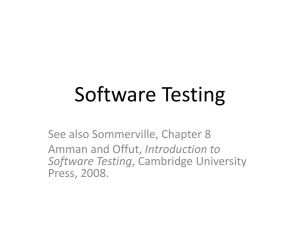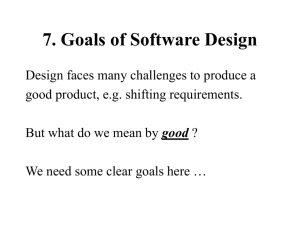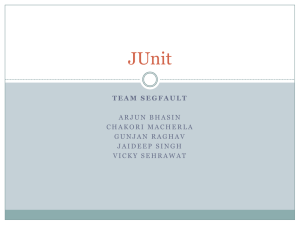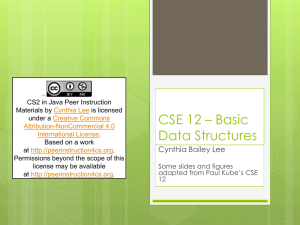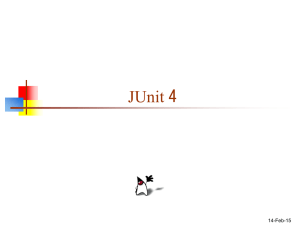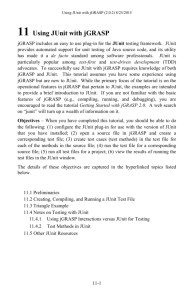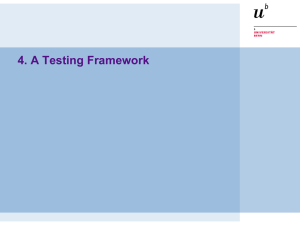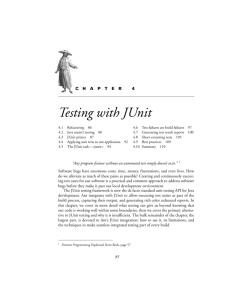Lecture 3
advertisement
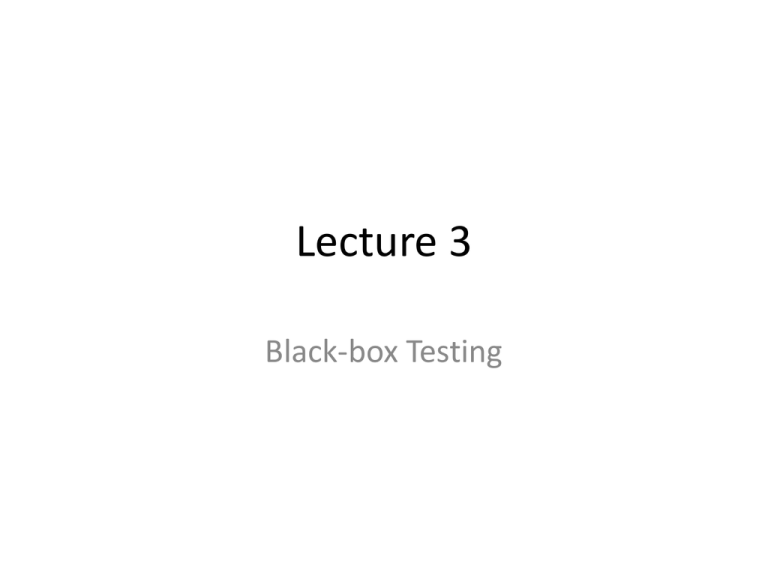
Lecture 3 Black-box Testing Black-box Testing + + + + - Test cases are constructed without reference to the code structure Can test the requirements not the code Can overcome combinatorial explosions Complementary to glass-box testing Insensitive to code refactoring Hard to find test verdicts – aka oracle problem Hard to define coverage Large volume of testing – user profiles? Use cases are an excellent source of tests Some Methods • • • • Random testing Boundary value testing N-wise and pairwise testing Testing from use cases and a practical framework: JUnit Random Testing • Generate input vectors (or sequences) at random, fire into system and observe. • Easy or tricky to implement – Low level data types … e.g. Int … easy – High level data types … e.g. graphs … tricky • High volume of test cases … but is that good structural coverage? • Good for low input dimension 1-5? – But poor for high input dimension Random Testing • Oracle step is difficult to automate without precise requirements • Set up and tear down must also be considered • Does random distribution match expected distribution? • Are some data combinations meaningless? Data interdependencies and constraints! – Example consider calendar combinations: – Year/month/day/day of week – 1961/02/29/Wednesday … is this legal or not? • Can try to filter out bad data but this can be very slow The Curse of Dimensionality • Most programs take a large amount of input data. • Define problem dimension D to be the total number of input variables to the SUT. • Question: how to count structured variables e.g. arrays? • Example: – 32 bit integers, – 10 integer input variables – 2320 possible input values • This is the curse of (all) high dimensional problems • c.f. multivariate integration in physics! 1st solution: Boundary Value Testing • Choose a small set of boundary values for each variable e.g. Bi = max+, max, max-, min-, min, min+ , • • • • say C choices for each input variable vi Boundary values might be chosen with reference to user requirements. Test suite TS is all combinations of B1 ,…, BD Cartesian Product TS = B1 … BD Test suite size TS = B1 … BD = CD - e.g. 6D for Bi above. • Still face exponential explosion! Example • • • • • Suppose D = 3, C = 2, then CD = 23 = 8. Suppose V1 = Mon, Sun V2 = A, Z V3 = 0, Maxint (positive integers) TS = (Mon, A, 0), (Sun, A, 0), (Mon, Z, 0), (Sun, Z, 0), (Mon, A, Maxint), (Sun, A, Maxint), (Mon, Z, Maxint), (Sun, Z, Maxint) Clearly TS has size 8 In general TS has size CD which is exponential in the problem dimension D. 2nd solution – n-Wise Testing Let D be the dimension of the input space. Let Vi = ti : C i 1 be set of C typical values for each input variable vi, for D i 1 Let di Vi be a default value for vi , for D i 1 An n-wise test case is an input vector ( i1, …, iD ) such that n elements are chosen from V1, …, Vj and the remaining D-n elements chosen from d1,…,dj. An n-wise test suite TSn consists of n-wise test cases containing every typical value. Example: 1-wise testing • Choose D=3, n = 1, and we get 1-wise testing of a 3dimensional testing problem. • Choose defaults d1 = Sat, d2 = A, d3 = 1, and k=2 typicals • V1 = Sat, Sun • V2 = A, B • V3 = 1, 2 • Then TS1 = (Sat, A, 1), (Sun, A, 1), (Sat, B, 1), (Sat, A, 2) Clearly TS1 has size ((C-1)*D) +1 which is linear in D. (c.f. CD) So TS1 is small but has limited coverage. Example: 2-wise testing (aka all-pairs or pairwise testing) • • • • • • For the same problem suppose n = 2 Choose same defaults d1 = Sat, d2 = A, d3 = 1 and typicals V1 = Sat, Sun V2 = A, B V3 = 1, 2 TS2 = (Sat, A, 1), (Sun, A, 1), (Sat, B, 1), (Sun, B, 1) (Sat, A, 2), (Sun, A, 2), (Sat, B, 2) Clearly TS2 has size 7 which is not much bigger than TS1. In general TSn is much smaller than TSn+1. TS2 grows O(D2), which is still much slower than CD. Why Pairwise Testing? • Bugs involving interactions between three or more parameters are progressively less common[2]. • NASA database application. 67 percent of the failures were triggered by only a single parameter value, 93 percent by twoway combinations, and 98 percent by three-way combinations [13]. • 10 UNIX commands. Cohen et al. showed that the pairwise tests gave over 90 percent block coverage [9]. • Medical software devices. Only 3 of 109 failure reports indicated that more than two conditions were required to cause the failure [14]. Why Pairwise Testing • Browser and server. More than 70 percent of bugs were detected with two or fewer conditions (75 percent for browser and 70 percent for server) and approximately 90 percent of the bugs reported were detected with three or fewer conditions (95 percent for browser and 89 percent for server) [13]. • User interface software at Telcordia. Studies [8] showed that most field faults were caused by either incorrect single values or by an interaction of pairs of values. Their code coverage study also indicated that pairwise coverage is sufficient for good code coverage. • Established tools, e.g. PICT • See www.pairwise.org Test Cases from Use Cases • Instantiate a scenario with concrete data values, and expected results. • Different flows lead to different use cases – Sunny day and rainy day scenarios • • • • Use graph coverage to measure use case coverage Structured and easy to use Natural focus on most significant use cases Good approach to system and acceptance testing, but may be difficult and unit and integration levels UseCaseName: PurchaseTicket Precondition: The passenger is standing in front of ticket distributor and has sufficient money to purchase a ticket. Sequence: 1. The passenger selects the number of zones to be travelled, If the passenger presses multiple zone buttons, only the last button pressed is considered by the distributor. 2. The distributor displays the amount due 3. The passenger inserts money 4. If the passenger selects a new zone before inserting sufficient money, the distributor returns all the coins and bills inserted by the passenger 5. If the passenger inserted more money than the amount due the distributor returns excess change. 6. The distributor issues ticket. 7. The passenger picks up the change and ticket. Postcondition The passenger has an appropriate ticket and change or else their original amount of money. TestCaseName: PurchaseTicket_SunnyDay Precondition: The passenger is standing in front of ticket distributor and has two 5€ notes and 3 * 10 Cent coins Sequence: 1. The passenger presses in succession the zone buttons 2, 4, 1 and 2. 2. The distributor should display in succession the fares 1.25€ 2.25€, 0.75€ and 1.25€ 3. The passenger inserts a 5€ note 4. The distributor returns 3*1€ coins, 75Cent and a 2-zone ticket. Postcondition The passenger has a 2-zone ticket and right change. The path exercised through this use-case (as a graph) is: 1, 1, 1, 1, 2, 3, 5, 6, 7. We could also derive test cases that exercise other paths through the use-case i.e. rainy day scenarios (when something goes wrong) to test robustness. Unit Testing with JUnit • Developed by the XP community 2002 • Framework for automating the execution of unit test for Java classes • Write new test cases by subclassing the TestCase class • Organise TestCases into TestSuites • Automates testing process • Built around Command and Composite patterns Why use Junit? • Junit tightly integrates development and testing, supports the XP approach • Allows you to write code faster while increasing quality (???) – Can refactor code without worrying about correctness • JUnit is simple. – Easy as running the compiler on your code • JUnit tests check their own results (oracle step) and provide immediate feedback – No manual comparison of expected with actual – Simple visual feedback • JUnit tests can be composed into a hierarchy of test suites – Can run tests for any layer in the hierarchy • Writing JUnit tests is inexpensive – No harder than writing a method to exercise the code • JUnit tests increase the stability of software – More tests = more stability • Junit tests are developer tests – Tests fundamental building blocks of system – Tests delivered with code as a certified package • Junit tests are written in Java – Seamless bond between test and code under test – Test code can be refactored into software code and vice-versa – Data type compatibility (float, double etc.) • Junit is free Junit Design • • • • A TestCase is a Command object A class of test methods subclasses TestCase A TestCase has public testXXX() methods To check expected with actual output invoke assert() method • Use setUp() and tearDown() to prevent side effects between subsequent testXXX() calls Test Run(TestResult) Test TestSuite testName:String run(TestResult) setUp() tearDown() runTest() Test setUp() tearDown() run(TestResult) addTest() Run(TestResult) • TestCase objects can be composed into TestSuite hierarchies. Automatically invoke all the testXXX() methods in each object • A TestSuite is composed of TestCase instances or other TestSuite instances • Nest to arbitrary depth • Run whole TestSuite with a single pass/fail result • Get your own installation instructions Writing a Test Case • Define a subclass of TestCase • Override the setUp() method to intialise object(s) under test • Optionally override the tearDown() method to release objects under test • Define 1 or more public testXXX() methods hat exercise the object(s) under test and assert expected results Import junit.framework.TestCase Public class ShoppingCartTest extends TestCase Private ShoppingCart cart; Private Product book1; Protected void setUp() Cart = new ShoppingCart(); Book1 = new Product(“myTitle”, “50€”); Cart.addItem(book1) Protected void tearDown() //release objects under test here if necessary Public void testEmpty() Cart.empty(); // empty out cart assertEquals(0,cart.getItemCount() ); Public void testAddItem() Product book2 = new Product(“title2”, “65€”); cart.addItem(book2); double expectedBalance = book1.getPrice() + book2.getPrice(); assertEquals(expectedBalance, cart.getBalance()); assertEquals(2, cart.getItemCount() ); Public void testRemoveItem() throws productNotFoundException Cart.removeItem(book1); assertEquals(1, cart.getItemCount() ); Public void testRemoveItemNotInCart() try Product book3 = new Product(“title3”, “10€”); Cart.removeItem(book3); fail(“should raise a ProductNotFoundException”); Catch(ProductNotFoundException expected) //passed the test! // of class ShoppingCartTest
